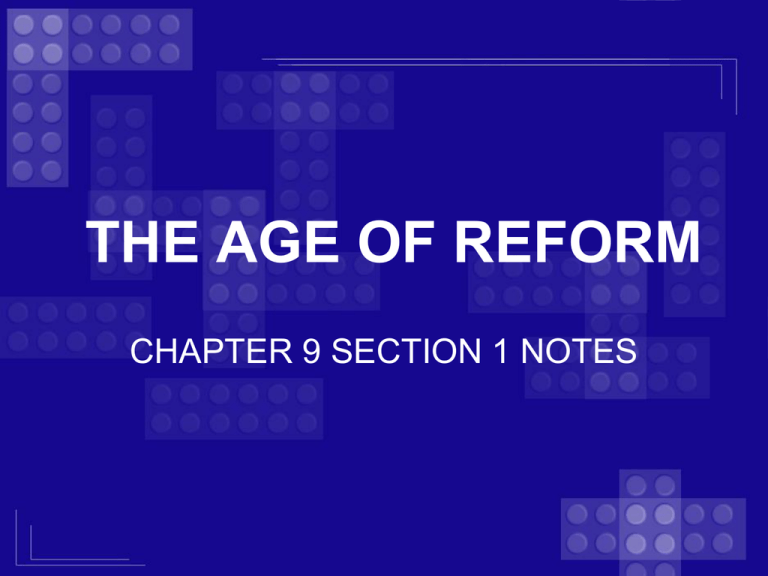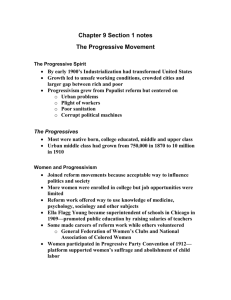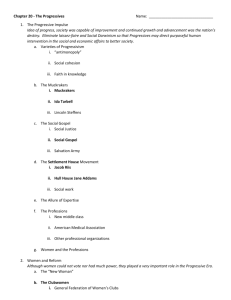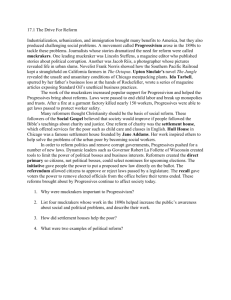THE AGE OF REFORM
advertisement

THE AGE OF REFORM CHAPTER 9 SECTION 1 NOTES The Progressive Spirit • By early 1900’s Industrialization had transformed United States • Growth led to unsafe working conditions, crowded cities and larger gap between rich and poor • Progressivism grew from Populist reform but centered on urban problems • Plight of workers • Poor sanitation • Corrupt political machines THE PROGRESSIVES • Most were native born, college educated, middle and upper class • Urban middle class had grown from 750,000 in 1870 to 10 million in 1910 WOMEN AND PROGRESSIVES • Joined reform movements because acceptable way to influence politics and society • More women were enrolled in college but job opportunities were limited • Reform work offered way to use knowledge of medicine, psychology, sociology and other subjects WOMEN AND PROGRESSIVES • Ella Flagg Young became superintendent of schools in Chicago in 1909—promoted public education by raising salaries of teachers • Some made careers of reform work while others volunteered – General Federation of Women’s Clubs and National Association of Colored Women • Women participated in Progressive Party Convention of 1912—platform supported women’s suffrage and abolishment of child labor Progressive Issues • Dangerous workplace • Major concern was way corporate America did business • In 1910 70% of industrial workers had 54 hour work weeks – Higher accident rates • 25% of one Pittsburgh steel mill workforce injured or killed per year from 1907-1910 Progressive Issues • Demand limits on corporate power – Promoted laws to limit monopolies and help small businesses – Called for 8 hour work day – Minimum wage – Safer work conditions – Abolishment of child labor Social Problems • Wanted people to have greater control over government • New election reforms and other reforms more responsive to desire of voters • Inspired by spirit of social justice – Believed in power of science and technology to solve social problems • John Dewey “education should prepare students to function in society, not just give them factual information Inspiration for Reform • Popular magazines such as Munsey’s and Everybody’s published stories about corruption in politics and business as well as social problems • McClure’s Magazine founded by S.S. McClure in 1893 • Teddy Roosevelt coined term Muckrakers to describe investigative journalists Inspiration for Reform • October 1902 McClure’s publishes Tweed Days in St Louis by Lincoln Steffens and Claude Wetmore—describes St. Louis’s political machine and comparison to Boss Tweed of New York • Ida Tarbell writes series of 19 articles about “History of Standard Oil”—uncovering details about corrupt practices of John Rockefeller—published in McClure’s – Ida never wanted to be associated with muckrakers—her father’s company had been bought out by Standard Oil Muckraking Books • Lincoln Steffens writes Shame of the Cities in 1904— describes urban political corruption • Ray Stannard Baker writes Following the Color Line in 1908—describes plight of African Americans Writers and Social Problems – Novelists describe darker side of new industrial society’s effect on people • Theodore Dreiser writes Sister Carrie (1900) and The Financier (1912)—describing workers brutalized by greedy business owners • Edith Wharton describes how closed-mindedness of elite society leads heroine to social isolation and despair in The House of Mirth in 1905 Writers and Social Problems • The Promise of American Life published in 1909 by Herbert Croly argues that government should use regulatory and taxation power to promote welfare of its citizens • Jane Addams Democracy and Social Ethics (1902) urges private citizens to show more social responsibility – Although progressives wanted to transform society and its values they remained committed to Democracy for all citizens





